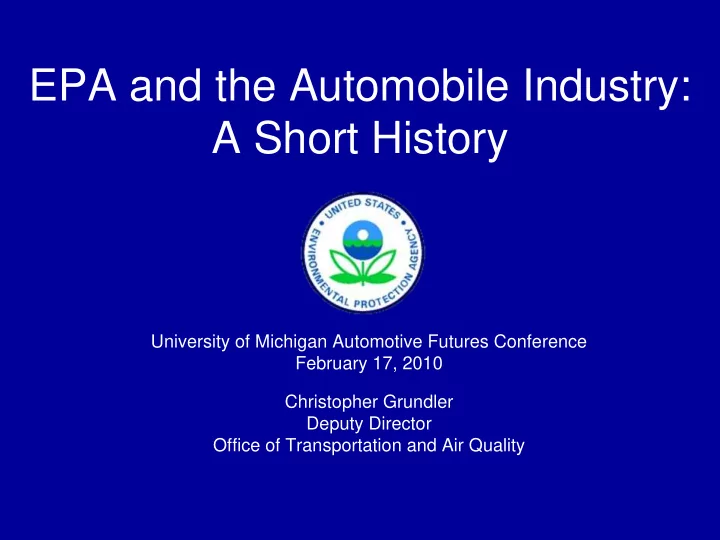

EPA and the Automobile Industry: A Short History University of Michigan Automotive Futures Conference February 17, 2010 Christopher Grundler Deputy Director Office of Transportation and Air Quality
The Early Years • EPA vs. The Automakers • Automakers vs. Big Oil • Emissions Standards and Technology
The 1990’s: A New Collaboration • Clean Air Act Amendments • Partnership for a New Generation of Vehicles – Cooperative Research and Development Agreements • Tier 2 Emission Standards – Systems Approach
U.S. Vehicle Emissions: A Major Public Policy Success Story • Cleaner and better – New cars are 98% cleaner (similar reductions for heavy-duty, nonroad, etc.) – Public health benefits far exceed the costs, often by 10:1 or more – Technology innovation also promoted better vehicle quality, reliability, and durability • Lower ambient pollution levels despite near tripling of U.S. GDP since 1970 • Model for rest of world
Progress Toward Clean Air 1970-2001 Pollution Down While Growth Continues
Clean Air vs. Energy Policy • Different Histories and Results • Willingness to Pay • Incremental change vs. New Fuels and Powertrains
Adjusted Fuel Economy, 1975- 2008 Adjusted Fuel Economy by Model Year (Annual Data) Adjusted MPG 30 25 Cars Both 20 15 Trucks 10 1970 1975 1980 1985 1990 1995 2000 2005 2010 Model Year
Where Has the Technology Gone ? 25.0 130% 24.0 222 hp 120% Weight / Horsepower changes relative to 1981 23.0 110% 22.0 mpg 22.0 100% Vehicle miles per gallon (adjusted) 20.8 mpg 21.0 90% 20.0 80% 19.0 70% 18.0 60% 17.0 50% 16.0 40% 15.0 30% 4117 lb 14.0 20% MPG 13.0 10% weight 12.0 0% horsepower 102 hp , 3203 lbs 11.0 -10% 1975 1980 1985 1990 1995 2000 2005 2010 2015
New World of Climate and Energy Imperatives: 2009- • The Drivers: – Science – The Law – Energy and Economic Security – State Initiatives • Consequences for Automakers
Taking a Big First Step: New National Policy Announced • May 2009: President announces New National Policy for Automobile Emissions • EPA worked closely with President’s Auto Task Force in designing new national policy • Unprecedented stakeholder support – California and 13 other states – Automakers and UAW – Environmental groups • September 2009: EPA proposes first-ever light-duty vehicle GHG standards, jointly with DOT CAFÉ standards • New standards cover Model Year 2012-2016 vehicles
Impacts for MY2012-2016 Vehicles • National Program will achieve substantial reductions in fuel consumption and GHG emissions – Increase fuel economy by approximately five percent every year – 2016 fleet average: 250g/mile 34.1-35.5mpg – Reduce greenhouse gas emissions by nearly 950 million metric tons – Conserve 1.8 billion barrels of oil • Vehicle cost – Average MY2016 vehicle will cost an extra $1000 – Fuel savings will offset higher up front costs in 3 years • Impact on Society – Net benefits of about $200 billion
Innovative Features • Emission banking and trading elements • Flex-fuel vehicle (FFV) credits – MY2012 – 2015 credits similar to CAFE, MY2016+ credits based on actual E85 fuel use • Air conditioning HFC and CO 2 -related reduction credits • Early credit opportunities for doing better • Advance technology credits
Technology Feasibility • Large penetration of currently available technologies – Gasoline direct injection – Engine Down-sizing with Turbocharging – 6 speed transmissions/dual clutch – High efficiency, low lead AC systems – Engine start-stop systems • Little to no penetration of diesel, hybrid, or electric technologies • Large opportunity for future reductions
Robust Technical Analysis and Transparency • Proposed Standards based on significant new analysis – new peer reviewed estimates for indirect and direct mfg costs – new technology effectiveness estimates based on vehicle simulation modeling and certification data – new peer-reviewed technology and cost model • Transparency – baselines and projections based on publicly reviewable data – model inputs and outputs available for review – commenters can use data to do alternative analysis
Status of Proposal • 120,000 Comments Received • Key Issues Analytical: – Social cost of carbon – Consumer welfare – Upstream GHG issues • Final Rule March 31, 2010
Looking to the Future Important to Align Federal Policy Levers: • Regulatory Policy • Tax Policy • Research & Development Policy
Recommend
More recommend